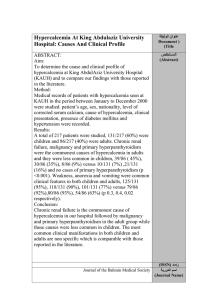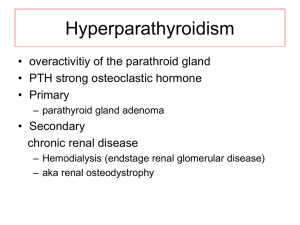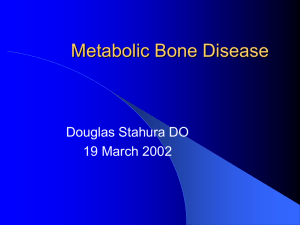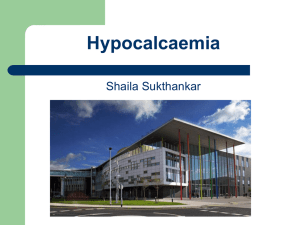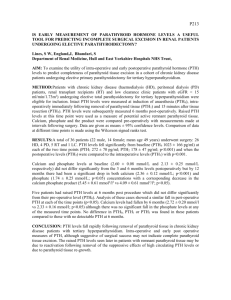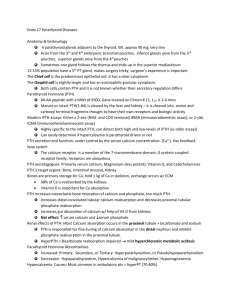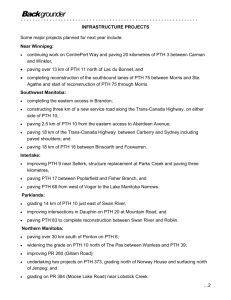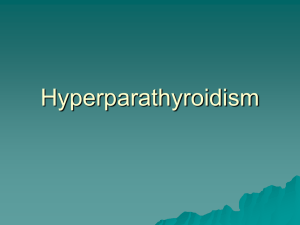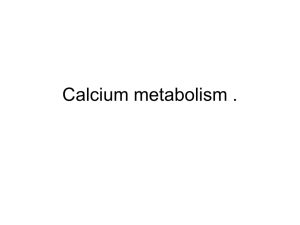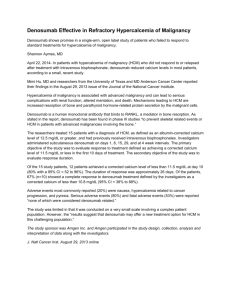Hypercalcemia
advertisement
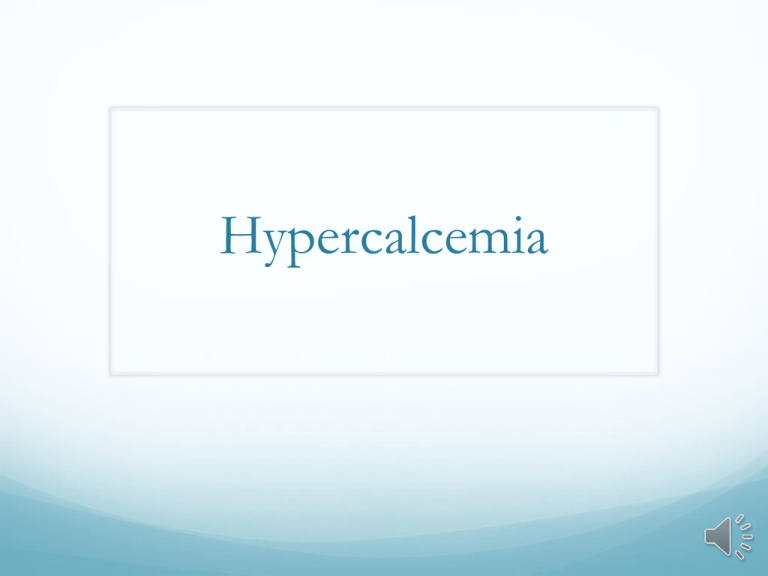
Hypercalcemia Case 56 Y O F with generalized body pain for 1 day Also decreased PO intake Expressive aphasia due to CVA, cannot give further history PMH to de discussed later… PE: Vitals stable Moderate respiratory distress Somnolent but arousable Breath sounds only in R chest Case, Continued Labs: Chem: 138/3.5/94/33/40/0.5 <114 – baseline BUN 7 Ca 19.8 – 11.9 one week prior CXR: complete opacification of L hemi-thorax. Volume loss, scarring and bronchiectasis in R lung Next: What’s the first test you would order? And what’s the diagnosis? Answers PTH < 3 when repeat Ca 18.6 History of NSCLS, squamous cell carcinoma, with intrabronchial invasion Important concepts in endocrine: 1- Two labs values are better than one; 3 is even better! 2- Timing 3- Inappropriately “normal” values Synthesis and Metabolism of Vitamin D in the Regulation of Calcium, Phosphorus, and Bone Metabolism. Holick MF. N Engl J Med 2007;357:266-281. Diagnostic Work Up PTH PTH-dependent •Primary Hyperparathyroidism •Familial Hypocalciuric Hypercalcemia •Lithuim Toxocity •Tertiary Hyperparathyroidism PTH-independent •Hypercalcemia of Malignancy •Vit D Intoxication •Granulomatous Disease •Hyperthyroidism •Vit A Intoxication •Adrenal Insufficiency •Milk-Alkali Syndrome •Thiazide Diuretics •Immobilization Why is PTH so important? General Rules PHPT is at least twice as common as all other causes combined Specially if pt seems well, hyperCa was found incidentally or is mild, stable or known to be of long duration More than 90% of pts referred to endocrine have PHPT Among ill or hospitalized pts, malignancy is the cause in more than 50% of cases Confirm elevated Ca levels by repeating test and checking ionized Ca History, PE, prior lab values, …. Primary Hyperparathyroidism Primary abnormality of parathyroid tissue Inappropriate secretion of PTH What is appropriate hypersecretion of PTH in response to hypocalcemia? Excessive PTH Increased renal Ca reabsorption Phosphaturia 1,25-OH2-Vit D synthesis Bone resorption Primary Hyperparathyroidism Etiology One or more parathyroid adenomas (75-80%) Diffuse hyperplasia of all glands (20%) Parathyroid carcinoma (1-2%) “Classic” manifestations Bone: increased resorption Renal: recurrent Ca stones, nephrocalcinosis, impaired concentrating ability, renal failure GI: nausea, vomiting, constipation, abd pain, pancreatitis Neuropsychiatric symptoms * “Contemporary” PHPT Many pts are incidentally found, asymptomatic Some have nl Ca and elevated PTH, found during work up of osteopenia Natural course variable: bone loss, kidney disease, mortality Management: observation vs. surgery Hypercalcemia of Malignancy Most malignancies produce hyperCa only when far advanced Pts usually die 1-2 months after hypercalcemia is discovered Polydipsia, polyuria, constipation, nausea, vomiting, but especially dramatic changes in mental status Mechanism Local osteolytic hypercalcemia: bone mets, most often in MM and breast cancer Humoral hypercalcemia of malignancy: mediated by PTHrP, mimics all actions of PTH. Squamous cell cancers (lung, H&N, esophagus, cervix), breast cancer, RCC, bladder. Vit D Intoxication Needs ingestion of about 100,000 IU of vit D per day In US most often Iatrogenic Hypercalcemia can be severe and prolonged (fat stores) 25-OH-Vit D levels dramatically elevated 1,25-OH2-Vit D normal or even low due to down regulation of renal 1α-hydroxylase by low PTH levels Granulomatous Disease Sarcoidosis, TB, fungal infections, HIV-related PCP infection, Crohn’s disease Unregulated production of active Vit D by macrophages Pts unusually sensitive to vit D an can become hypercalcemic after exposure to ultraviolet light, or oral vit D intake Misc. Causes Hyperthyroidism Ca rarely >11 Direct action of thyroid hormone to promote bone resorption Vit A Intoxication Requires ingestion of > 10x RDA (5000 IU/d) Also Accutane (acne) and Retin-A (acute promyelocytic leukemia) Adrenal Insufficiency Thiazide Diuretics: in PHPT, sarcoidosis, excessive Ca intake Misc. Causes Milk-Alkali syndrome Hypercalcemia, metabolic alkalosis, renal failure First described when milk and Na bicarb were used to treat PUD Now seen with increasing use of Ca bicarb for PUD and osteoporosis Immobilization Spinal cord injury or excessive casting Increased bone resorption Peak Ca in 4 week, can last up to one year Management Severe hypercalcemia > 14 mg/dl Unusual in PHPT, unless a secondary mechanism is present Dehydration from nausea, vomiting, diuretics Immobilization Large PO calcium intake Severe acute hypercalcemia usually result of malignancy Should we treat? Treatment: 1, 2, 3, … Correct Intravascular volume depletion: NS 2-4 lit/d Discontinue diuretics +/_ furoemide Bisphosphonates: first choice in management of severe hypercalcemia caused by osteolytic bone resorption Not in milk-alkali syndrome Ca decreases within 24 h, reaches nadir within 1 week Use half the dose in moderate renal insufficiency (GFR>30) Effect lasts 1 week to several months Treatment Calcitonin: inhibits osteoclast function Use with bisphosphonates for more rapid onset of action (a few hours) Ca decreases by 1-2 mg/dl Effect lasts a few days Steroids: PO or IV Consider early in Vit D mediated hypercalcemia, including granulomatous disease and lymphoma Treatment Follow Up Ca repeated, 18.6 with PTH < 3 PTHrP 55 (15-27) 25-OH-Vit D and 1,25-OH2-Vit D <8 IV hydration Calcitonin 200 IU q 12 (Ca 17.6 after 1st dose) Pamidronate 60mg IV infusion 48 hours after admission Ca 12.9 Transferred to pall care, expired 6 d after admission Case 1 49 y o F with laryngeal Ca s/p laryngectomy/chemo and RT with resultant hypothyroidism and hypoparathyroidism on replacement p/w weakness Ca 15.6 PTH < 3 Cr 1.3 (baseline 0.8) CO2 36 Dx? Case 2 74 Y o M with colorectal Ca, dementia, dependant on ADL’s p/w AMS Ca 14.2 – Hgb 9 – Cr 5.1 PTH 21.4 SPEP: no M spike, UPEP not sent PTHrP 23 25-OH-Vit D 35.7, 1,25-OH2-Vit D 16 Dx? Ca 9.8 after hydration Case 3 84 Y O F with Ehlers-Danlos syndrome, professor of pediatric neurology at Einstein p/w AMS Ca 16.2 PTH<3 SPEP, UPEP negative 25-OH-Vit D 127 Has been taking Vit D 5000 IU daily for “years” Case 4 82 Y o f with HTN, endometrial Ca, COPD, morbid obesity p/w inability to walk and b/l knee pain Ca 16.9 PTH 7.7 Cr 1.6 (taking NSAIDs), Hgb 10.6 25-OH-Vit D 27.2, 1,25-OH2-Vit D < 8 SPEP: + M spike – serum free lambda >12,000 Bone survey: lucency in calvarium, b/l femur and humerus Rx with IV hydration and steroids (semi-chemo)
